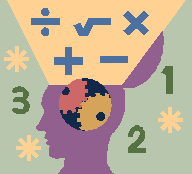
{This week’s Spotlight on the Crew article is brought to you from Julie, at Creatin Classical Chaos.}
Mental math is not only about being able to do the problems in your head, but more importantly understanding what strategies are used to solve the problem. Adults use mental math for everyday calculations more than 75% of the time. Children use the strategies that they understand, which will vary depending on developmental level.
Why teach mental math?
- To develop a strong number sense. Children with a strong number sense understand numbers, how they interact, their relationships, how to represent them, and can visualize them.
- To develop mastery. This allows children to efficiently perform a task with certainty. They are able to explain how they arrived at an answer and also understand that there is more than one way to get there.
Progression of skills
Developing a number sense is the basis of all further mathematical learning. Of course this takes much repetition and reinforcement. When kids start out, in the concrete stage, they must use “things” (manipulatives) to represent numbers. As they progress in their development they move on to the representational (connecting) stage. Eventually they will move into the abstract (symbolic) stage. This timeline varies from child to child, but usually between 5 and 7 years old they have developed a level of abstract thinking and can move into using the mental math stratagies that will be covered here. When learning new skills it is important to remember, that no matter the stage the child is in, these new skills need to be presented with concrete or representational “things” to deepen their understanding.
Since I am focusing on the grammar stage, I am skipping over all of the extremely important early learning skills that have got them to this point including one-to-one correspondence, composing and decomposing groups of items, and patterning. Patterns play a huge roll at all stages of math and I cannot encourage pattern play enough.
Beginning Mental Math Stratagies
Understanding and Visualizing 1- 10
Subitizing- This is the early basis for addition. Kids learn to recognize number patterns as both parts and a whole. This is very helpful for children to begin learning before starting formal addition lessons. Patterns, patterns, and more patterns. As they master the arrangements, change them up to more complex ones. You can make up flashcards using dot patterns and/or shape arrangements, use 10 frames, finger patterns, or even dominos. Show the arrangement to the child for a few seconds, cover it, and have the child give you the number. You can and eventually should also ask them how they knew what the answer was. Once they learn the smaller numbers they will see the arrangements in parts to get a whole. They will then be able to say, “It was 8 because there was a 3 and a 5.” Or something along those lines.
Composing and Decomposing numbers- ex. How many ways can we make 6? How many ways can we split a group of 6? What is 6?
Complements of 10- There are many ways to teach complements, but my favorite is with fingers. Kids really only have to learn five facts to know all of the complements of 10. With fingers you hold up all 10 fingers. Call out a number (5-10) and have them leave up that many fingers. The fingers down is its complement. Have them focus on how many are down rather than how many are up. After they practice using their own fingers they will begin to visualize the complements with ease. Then do it without fingers and call out a number and have them say its complement. This is a fun game and can waste some time waiting in line at the grocery store.
Addition
Counting on – Only use if numbers are no more than four apart. Some say only three apart, but four has worked fine for us. Ex. What comes after__? Start at 4 and count to 7. How many did you count? What is (1,2,3,4) more than (6)?
Doubles/ Doubles +1 and -1
Any number + 0
Any number(1-9) + 1 and +2
Commutative property 3+2=5 or 2+3=5
10 + (1-9)
Subtraction
Counting back- Only use if numbers are no more than four apart. See addition examples above.
Counting up- finding the difference
Using addition- Thinking of the inverse relationship. This is where working on fact families is helpful. Kids begin to see numbers as part+part=whole.
Finding doubles- Once they can see numbers as parts of a whole they will be able to compose/decompose numbers to find what is familiar.
Using 10 or Compensation- Changing the subtrahend to a 10 and then adjusting answer. This works best with within two of the number ten. Ex. 17-9=8 or 18-10=8
Multiplication and Division
At the beginning these are no more than an introduction using repeated addition, skip counting, and grouping. Word problems with manipulatives are the easiest way to approach these. Kids can relate well to “We have 6 cookies, how many do we each get if we shared them equally?” Trust me, these little ones know how to divide. They do not want to get less cookies than their brother or sister.
All of the strategies show should be introduced with manipulatives. As the kids play with the numbers they will discover how they work, learn the “why’s” about how they work, and be able to efficiently perform the task with certainly. Mastery!
I hope this has been helpful and gives you a jumping off point for teaching your little ones.
 Julie is a registered nurse turned stay-at-home homeschool mom to her youngest two, ages 4 and 5. She never imagined she would be at home, homeschooling, raising chickens, tending garden, baking, canning and loving every minute of it. Julie blogs her adventures at Creatin Classical Chaos.
Julie is a registered nurse turned stay-at-home homeschool mom to her youngest two, ages 4 and 5. She never imagined she would be at home, homeschooling, raising chickens, tending garden, baking, canning and loving every minute of it. Julie blogs her adventures at Creatin Classical Chaos.
